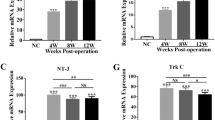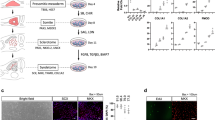Abstract
A major challenge in tendon injury is the weak intrinsic healing capacity of tendon that may cause rupture of the repair after surgery. Growth factors are believed to be critical during tendon healing. This study aimed to investigate the effects of vascular endothelial growth factor (VEGF) genes delivered by adeno-associated virus (AAV) vectors on tendon healing and molecular events involved in a chicken model. A total of 128 deep flexor tendons in the long toes of chickens were completely transected and injected with 2 × 109 particles of AAV2-VEGF or saline before surgically repaired. At postoperative 4, 6 and 8 weeks, the gliding excursions of tendon were recorded and adhesions around the repair site scored. At 2, 4, 6 and 8 weeks, the ultimate strengths of the healing tendons were tested. Terminal deoxynucleotide transferase dUTP nick end labeling assay were performed to detect cellular apoptosis and immunofluorescence staining to detect type III collagen and matrix metalloprotease-2 (MMP2) expression in tendon tissues. The gliding excursion and adhesion score were similar between AAV2-VEGF-treated tendons and the control tendons. Delivery of AAV2-VEGF significantly increased ultimate strength of the healing tendons at postoperative 4, 6 and 8 weeks (P<0.05). Apoptotic reaction was inhibited from postoperative 2 to 8 weeks in tendon core area or surface area. Type III collagen expression was enhanced at 2, 4, 6 and 8 weeks and MMP2 expression enhanced at 2 and 4 weeks after AAV2-VEGF transfection. The current study confirms the therapeutic efficacy of AAV2-VEGF in improving healing strength of tendon without aggravating adhesion formation after tendon injury, shedding light on the application of molecular therapy in modulating tendon healing.
This is a preview of subscription content, access via your institution
Access options
Subscribe to this journal
Receive 12 print issues and online access
$259.00 per year
only $21.58 per issue
Buy this article
- Purchase on Springer Link
- Instant access to full article PDF
Prices may be subject to local taxes which are calculated during checkout





Similar content being viewed by others
References
Beredjiklian PK . Biologic aspects of flexor tendon laceration and repair. J Bone Joint Surg Am 2003; 85-A: 539–550.
James R, Kesturu G, Balian G, Chhabra AB . Tendon: biology, biomechanics, repair, growth factors, and evolving treatment options. J Hand Surg Am 2008; 33: 102–112.
Tang JB . Indications, methods, postoperative motion and outcome evaluation of primary flexor tendon repairs in Zone 2. J Hand Surg Eur 2007; 32: 118–129.
Wu YF, Tang JB . Recent developments in flexor tendon repair techniques and factors influencing strength of the tendon repair. J Hand Surg Eur Vol 2014; 39: 6–19.
Tang JB, Cao Y, Zhu B, Xin KQ, Wang XT, Liu PY . Adeno-associated virus-2-mediated bFGF gene transfer to digital flexor tendons significantly increases healing strength. an in vivo study. J Bone Joint Surg Am 2008; 90: 1078–1089.
Suwalski A, Dabboue H, Delalande A, Bensamoun SF, Canon F, Midoux P et al. Accelerated Achilles tendon healing by PDGF gene delivery with mesoporous silica nanoparticles. Biomaterials 2010; 31: 5237–5245.
Tang Y, Leng Q, Xiang X, Zhang L, Yang Y, Qiu L . Use of ultrasound-targeted microbubble destruction to transfect IGF-1 cDNA to enhance the regeneration of rat wounded Achilles tendon in vivo. Gene Therapy 2015; 22: 610–618.
Zhang F, Liu H, Stile F, Lei MP, Pang Y, Oswald TM et al. Effect of vascular endothelial growth factor on rat Achilles tendon healing. Plast Reconstr Surg 2003; 112: 1613–1619.
Kaux JF, Janssen L, Drion P, Nusgens B, Libertiaux V, Pascon F et al. Vascular endothelial growth factor-111 (VEGF-111) and tendon healing: preliminary results in a rat model of tendon injury. Muscles Ligaments Tendons J 2014; 4: 24–28.
Chen CH, Zhou YL, Wu YF, Cao Y, Gao JS, Tang JB . Effectiveness of microRNA substantially down-regulates TGF-beta gene expression of digital flexor tendons: an in vitro andin vivo study. J Hand Surg Am 2009; 34: 1777–1784.
Wang XT, Liu PY, Tang JB . Tendon healing in vitro: genetic modification of tenocytes with exogenous PDGF gene and promotion of collagen gene expression. J Hand Surg Am 2004; 29: 884–890.
Wang XT, Liu PY, Tang JB . Tendon healing in vitro: modification of tenocytes with exogenous vascular endothelial growth factor gene increases expression of transforming growth factor beta but minimally affects expression of collagen genes. J Hand Surg Am 2005; 30: 222–229.
Wang XT, Liu PY, Xin KQ, Tang JB . Tendon healing in vitro: bFGF gene transfer to tenocytes by adeno-associated viral vectors promotes expression of collagen genes. J Hand Surg Am 2005; 30: 1255–1261.
Chen CH, Cao Y, Wu YF, Bais AJ, Gao JS, Tang JB . Tendon healingin vivo: gene expression and production of multiple growth factors in early tendon healing period. J Hand Surg Am 2008; 33: 1834–1842.
Schulze-Tanzil G, Al-Sadi O, Wiegand E, Ertel W, Busch C, Kohl B et al. The role of pro-inflammatory and immunoregulatory cytokines in tendon healing and rupture: new insights. Scand J Med Sci Sports 2011; 21: 337–351.
Cheng P, Han P, Zhao C, Zhang S, Wu H, Ni J et al. High-purity magnesium interference screws promote fibrocartilaginous entheses regeneration in the anterior cruciate ligament reconstruction rabbit model via accumulation of BMP-2 and VEGF. Biomaterials 2016; 81: 14–26.
Durgam S, Stewart M . Cellular and molecular factors influencing tendon repair. Tissue Eng Part B Rev 2017, [Epub ahead of print].
Wu YF, Chen CH, Cao Y, Avanessian B, Wang XT, Tang JB . Molecular events of cellular apoptosis and proliferation in the early tendon healing period. J Hand Surg Am 2010; 35: 2–10.
Wu YF, Zhou YL, Mao WF, Avanessian B, Liu PY, Tang JB . Cellular apoptosis and proliferation in the middle and late intrasynovial tendon healing periods. J Hand Surg Am 2012; 37: 209–216.
Wu YF, Tang JB . Apoptosis in adhesions and the adhesion-tendon gliding interface: relationship to adhesion-tendon gliding mechanics. J Hand Surg Am 2013; 38: 1071–1078.
Jones ME, Mudera V, Brown RA, Cambrey AD, Grobbelaar AO, McGrouther DA . The early surface cell response to flexor tendon injury. J Hand Surg Am 2003; 28: 221–230.
Liu X, Wu H, Byrne M, Krane S, Jaenisch R . Type III collagen is crucial for collagen I fibrillogenesis and for normal cardiovascular development. Proc Natl Acad Sci USA 1997; 94: 1852–1856.
Page-McCaw A, Ewald AJ, Werb Z . Matrix metalloproteinases and the regulation of tissue remodelling. Nat Rev Mol Cell Biol 2007; 8: 221–233.
Loiselle AE, Bragdon GA, Jacobson JA, Hasslund S, Cortes ZE, Schwarz EM et al. Remodeling of murine intrasynovial tendon adhesions following injury: MMP and neotendon gene expression. J Orthop Res 2009; 27: 833–840.
Wang Z, Ma HI, Li J, Sun L, Zhang J, Xiao X . Rapid and highly efficient transduction by double-stranded adeno-associated virus vectors in vitro andin vivo. Gene Therapy 2003; 10: 2105–2111.
Choi SH, Lee HC . Long-term, antidiabetogenic effects of GLP-1 gene therapy using a double-stranded, adeno-associated viral vector. Gene Therapy 2011; 18: 155–163.
Elliot D, Barbieri CH, Evans RB, Mass D, Tang JB . IFSSH Flexor Tendon Committee Report 2007. J Hand Surg Eur Vol 2007; 32: 346–356.
Moriya K, Yoshizu T, Maki Y, Tsubokawa N, Narisawa H, Endo N . Clinical outcomes of early active mobilization following flexor tendon repair using the six-strand technique: short- and long-term evaluations. J Hand Surg Eur Vol 2015; 40: 250–258.
Moriya K, Yoshizu T, Tsubokawa N, Narisawa H, Hara K, Maki Y . Clinical results of releasing the entire A2 pulley after flexor tendon repair in zone 2C. J Hand Surg Eur Vol 2016; 41: 822–828.
Jordan MC, Schmitt V, Dannigkeit S, Schmidt K, Meffert RH, Hoelscher-Doht S . Surgical adhesive BioGlue does not benefit tendon repair strength: an ex vivo study. J Hand Surg Eur Vol 2015; 40: 700–704.
Lees VC, Warwick D, Gillespie P, Brown A, Akhavani M, Dewer D et al. A multicentre, randomized, double-blind trial of the safety and efficacy of mannose-6-phosphate in patients having Zone II flexor tendon repairs. J Hand Surg Eur Vol 2015; 40: 682–694.
Loiselle AE, Kelly M, Hammert WC . Biological augmentation of flexor tendon repair: a challenging cellular landscape. J Hand Surg Am 2016; 41: 144–149.
Wong R, Alam N, McGrouther AD, Wong JK . Tendon grafts: their natural history, biology and future development. J Hand Surg Eur Vol 2015; 40: 669–681.
Khor WS, Langer MF, Wong R, Zhou R, Peck F, Wong JK et al. Improving outcomes in tendon repair: a critical look at the evidence for flexor tendon repair and rehabilitation. Plast Reconstr Surg 2016; 138: 1045e–1058e.
Moriya K, Yoshizu T, Tsubokawa N, Narisawa H, Hara K, Maki Y . Outcomes of release of the entire A4 pulley after flexor tendon repairs in zone 2A followed by early active mobilization. J Hand Surg Eur Vol 2016; 41: 400–405.
Kozono N, Okada T, Takeuchi N, Hanada M, Shimoto T, Iwamoto Y . Asymmetric six-strand core sutures enhance tendon fatigue strength and the optimal asymmetry. J Hand Surg Eur Vol 2016; 41: 802–808.
Leppänen OV, Linnanmäki L, Havulinna J, Göransson H . Suture configurations and biomechanical properties of flexor tendon repairs by 16 hand surgeons in Finland. J Hand Surg Eur Vol 2016; 41: 831–837.
Gibson PD, Sobol GL, Ahmed IH . Zone II flexor tendon repairs in the United States: trends in current management. J Hand Surg Am 2017; 42: e99–e108.
Wu YF, Zhou YL, Tang JB . Relative contribution of tissue oedema and the presence of an A2 pulley to resistance to flexor tendon movement: an in vitro andin vivo study. J Hand Surg Eur Vol 2012; 37: 310–315.
Wu YF, Mao WF, Zhou YL, Wang XT, Liu PY, Tang JB . Adeno-associated virus-2-mediated TGF-β1 microRNA transfection inhibits adhesion formation after digital flexor tendon injury. Gene Therapy 2016; 23: 167–175.
Acknowledgements
YF Wu was supported by grants from the Natural Science Foundation of China (No. 81401797). WF Mao was supported by China Postdoctoral Science Foundation Grant (No. 2016M591895). JB Tang was supported by grants from the Natural Science Foundation of China (No. 81271985).
Author information
Authors and Affiliations
Corresponding author
Ethics declarations
Competing interests
The authors declare no conflict of interest.
Rights and permissions
About this article
Cite this article
Mao, W., Wu, Y., Yang, Q. et al. Modulation of digital flexor tendon healing by vascular endothelial growth factor gene transfection in a chicken model. Gene Ther 24, 234–240 (2017). https://doi.org/10.1038/gt.2017.12
Received:
Revised:
Accepted:
Published:
Issue Date:
DOI: https://doi.org/10.1038/gt.2017.12
This article is cited by
-
MOFs-Based Nitric Oxide Therapy for Tendon Regeneration
Nano-Micro Letters (2021)



